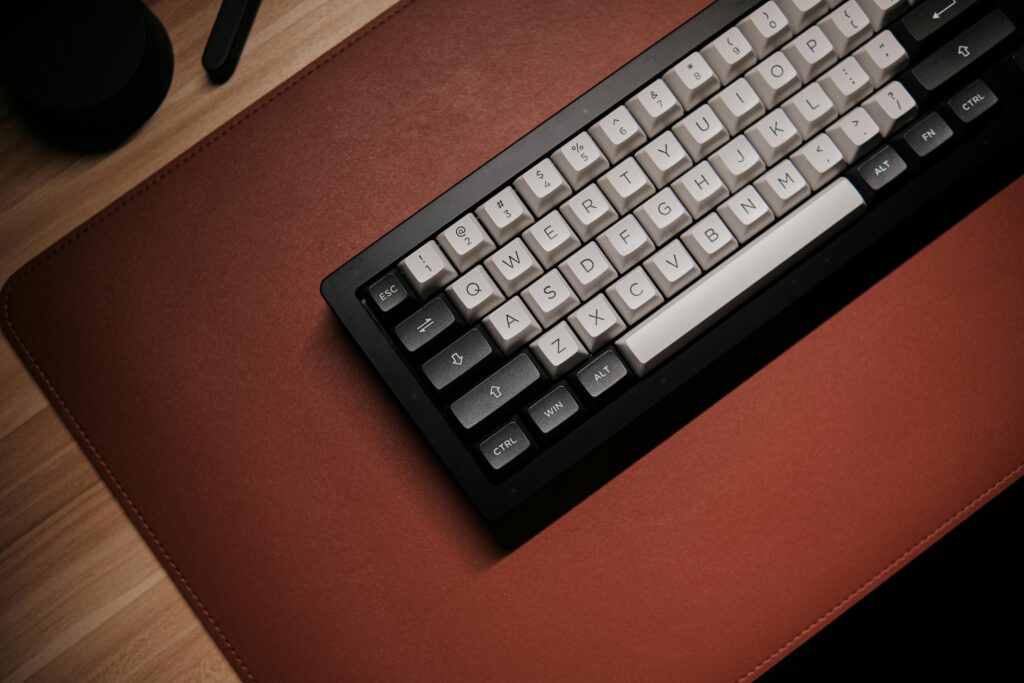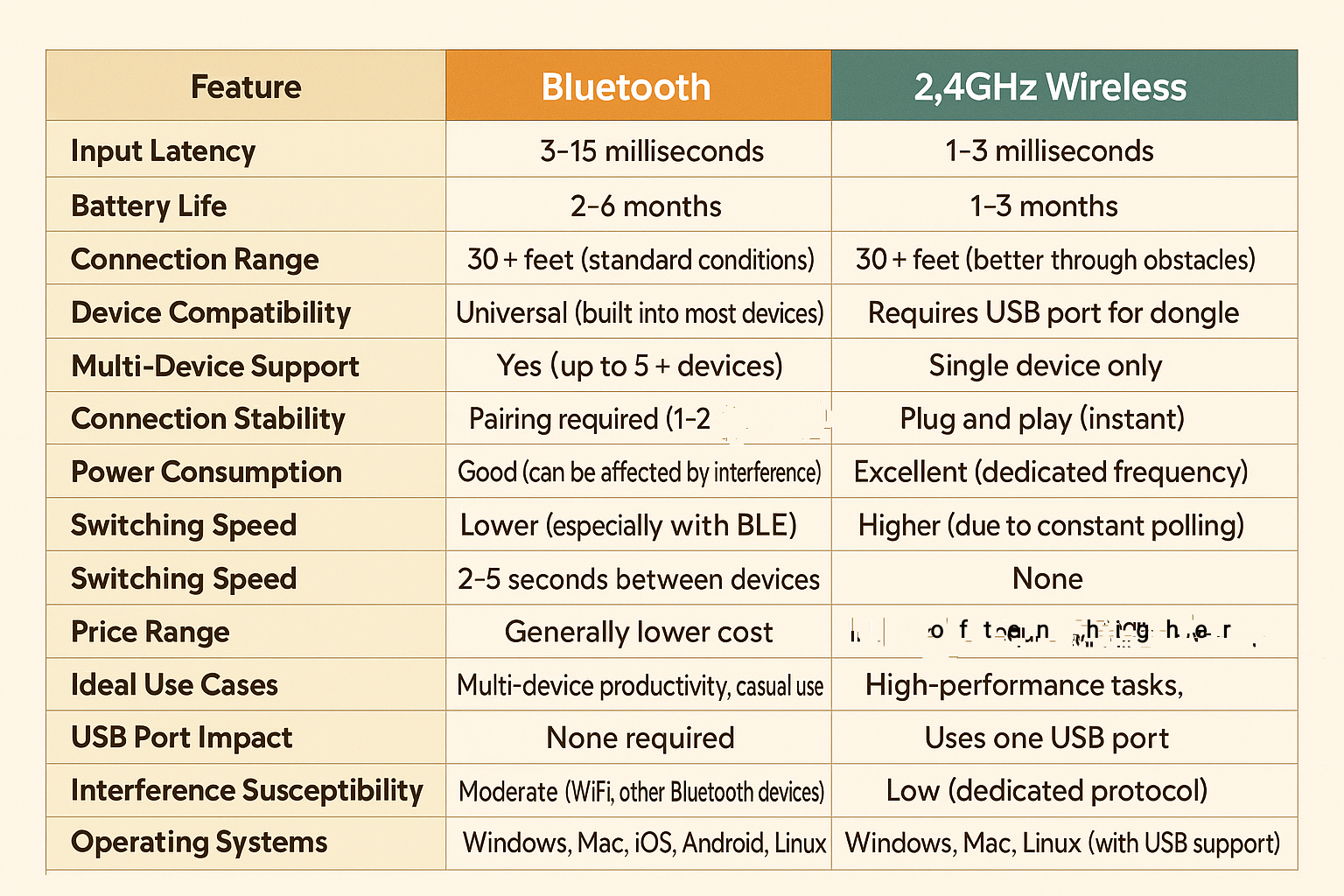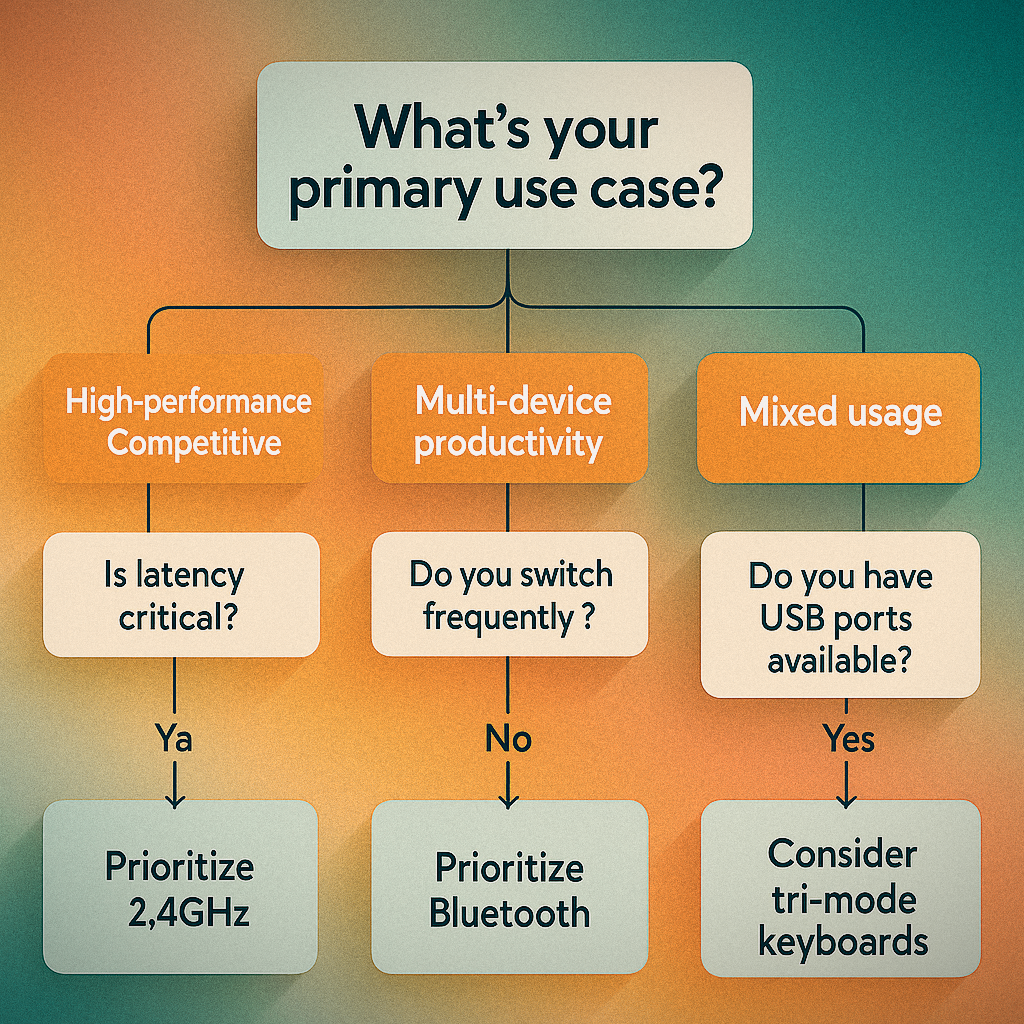The first question to consider is: which is better for wireless mechanical keyboards, Bluetooth or 2.4 GHz? When shopping for a wireless mechanical keyboard, you’ll encounter two primary connectivity options: Bluetooth and 2.4 GHz wireless. The best choice depends entirely on how you intend to use your keyboard.
If you frequently switch between multiple devices and want broad compatibility, Bluetooth is usually the better option. On the other hand, if you need ultra-low latency for high-performance tasks, 2.4 GHz wireless is the superior choice. Alternatively, a tri-mode keyboard offering both options can provide the best of both worlds.

This comprehensive comparison will break down the real-world differences between these technologies, helping you make the right choice for your specific needs and usage patterns.

*Affiliate Disclosure: This post contains affiliate links. If you purchase through these links, we may earn a small commission at no extra cost to you.*
Which is Better: Bluetooth or 2.4GHz for Wireless Mechanical Keyboards
Understanding Your Wireless Mechanical Keyboard Priorities
Before determining which connection type is better for you, it’s essential to honestly assess your primary use cases and requirements.
•Productivity and Work Usage
If high-performance computing is a priority, response time becomes critical. Even a few milliseconds of delay can affect precision work, competitive applications, or fast-paced tasks. Power users often prioritize connection stability and minimal latency over convenience features.
Consider how demanding your computing tasks are, what types of applications you use, and whether you engage in competitive activities. Fast-paced applications and real-time work are particularly sensitive to input lag, while casual computing tasks are more forgiving.
•High-Performance Requirements
For productivity work, the ability to seamlessly switch between devices often trumps ultra-low latency. Many professionals use multiple devices throughout their day – a desktop for heavy work, a laptop for meetings, and perhaps a tablet for presentations.
Think about your typical workday. Do you frequently switch between different computers? Do you work from multiple locations? Are you often in video calls where you need quick access to media controls?
•Multi-Device Scenarios
Modern digital life often involves juggling multiple devices. You might start writing a document on your laptop, continue editing on your desktop, and then review it on your tablet. The ability to use one high-quality keyboard across all these devices can streamline your workflow significantly.
Consider how many devices you actively use and whether you’d benefit from seamless switching between them without constantly re-pairing or using multiple keyboards.
•Battery Life Expectations
Wireless keyboards require power management considerations that wired keyboards don’t. Different connection types have varying impacts on battery life, and your usage patterns will determine how often you need to charge or replace batteries.
Think about whether you prefer rechargeable keyboards that you can plug in overnight or battery-powered options that might last months on a single set of batteries.

Bluetooth: Better for Multi-Device Flexibility
Bluetooth technology has become the standard for wireless peripheral connectivity, and for good reason. Its widespread adoption and built-in compatibility with virtually every modern device make it an attractive option for many users.
•How Bluetooth Works in Mechanical Keyboards
Bluetooth operates in the 2.4GHz frequency band but uses a different protocol than dedicated 2.4GHz keyboards. It creates a personal area network that can connect multiple devices simultaneously, with most modern keyboards supporting Bluetooth 5.0 or newer versions.
The connection process involves pairing, where devices exchange security keys and establish a trusted relationship. Once paired, devices typically reconnect automatically when in range, though this process can take a few seconds.
•When Bluetooth is Better
Universal Compatibility: The biggest advantage of Bluetooth is its universal nature. Nearly every laptop, smartphone, tablet, and modern desktop computer has built-in Bluetooth capability. You can connect your keyboard to a MacBook, switch to an Android tablet, and then connect to a Windows desktop without any additional hardware.
Multiple Device Support: Most Bluetooth mechanical keyboards can remember multiple paired devices and switch between them using hotkey combinations. This feature is invaluable for users who regularly work across different platforms or devices.
No USB Port Required: Since Bluetooth is built into most devices, you don’t need to sacrifice a USB port for a receiver dongle. This is particularly valuable on laptops and tablets with limited ports.
Lower Power Consumption: Modern Bluetooth implementations, especially Bluetooth Low Energy (BLE), are designed for extended battery life. Many Bluetooth keyboards can operate for months on a single charge or battery set.
•Bluetooth Limitations
Connection Latency: Bluetooth typically introduces 3-15 milliseconds of input delay, depending on the implementation and device. While this is imperceptible for typing and casual use, competitive users may notice it during fast-paced activities.
Connection Stability: Bluetooth can be affected by interference from other wireless devices, WiFi networks, and physical obstacles. Connection drops, while rare, can be more frequent than with dedicated 2.4GHz solutions.
Pairing Complexity: While generally straightforward, Bluetooth pairing can sometimes be finicky, especially when switching between different operating systems or older devices.
2.4GHz Wireless: Better for Performance-Critical Tasks
Dedicated 2.4GHz wireless technology represents a different approach to wireless connectivity, prioritizing performance and reliability over universal compatibility.
• How 2.4GHz Wireless Works
Understanding the practical differences between these technologies is easier with a direct comparison:
Unlike Bluetooth, dedicated 2.4GHz keyboards use proprietary protocols optimized for low latency and high reliability. The keyboard and receiver are specifically designed to work together, allowing for more aggressive optimization than universal standards allow.
These systems typically use frequency hopping or other interference avoidance techniques to maintain stable connections even in crowded wireless environments.
• When 2.4GHz is Better
Ultra-Low Latency: The primary advantage of 2.4GHz wireless is incredibly low input lag, often matching or nearly matching wired connections. Response times of 1-3 milliseconds are common, making these keyboards ideal for competitive applications and high-performance tasks.
Rock-Solid Reliability: Because the keyboard and receiver are designed as a matched pair, connection stability is typically excellent. Drops are rare, and reconnection is usually instantaneous.
Consistent Performance : 2.4GHz keyboards maintain consistent performance regardless of what other Bluetooth devices might be connected to your computer. There’s no sharing of bandwidth or processing resources with other wireless peripherals.
Longer Range : Many 2.4GHz implementations offer superior range compared to Bluetooth, allowing you to use your keyboard from across the room or even from another room in some cases.
• 2.4GHz Limitations
USB Port Requirement: You need to use a USB receiver dongle, which occupies a port on your device. This can be problematic on laptops or devices with limited USB connectivity.
Single Device Connection: Most 2.4GHz keyboards work with only one receiver at a time. If you want to use the keyboard with multiple devices, you’ll need to physically move the dongle or use a USB hub.
Compatibility Limitations: Devices without USB ports (like some tablets or smartphones) cannot use 2.4GHz keyboards without adapters.


Performance Comparison: Real-World Testing Results
-Latency Measurements
Independent testing consistently shows that 2.4GHz keyboards deliver input latency in the 1-3 millisecond range, while Bluetooth keyboards typically range from 3-15 milliseconds depending on the implementation and receiving device.
While these differences might seem small, they become noticeable during fast-paced activities or rapid typing. Professional users in competitive environments almost universally prefer wired or 2.4GHz wireless keyboards for this reason.
-Battery Life Comparison
Bluetooth keyboards generally offer superior battery life due to optimized power management protocols. Many Bluetooth mechanical keyboards can operate for 2-6 months on a single charge, while 2.4GHz keyboards typically last 1-3 months under similar usage conditions.
However, actual battery life depends heavily on usage patterns, backlighting settings, and specific keyboard implementation.
High-Performance Considerations: Which Technology Wins?
For high-performance applications, the choice between Bluetooth and 2.4GHz often comes down to the type of tasks you perform and your precision requirements.
-Competitive and Professional Use Requirements
Professional users and competitive applications typically prefer 2.4GHz wireless or wired connections due to minimal latency requirements. In scenarios where milliseconds matter, the 1-2ms advantage of 2.4GHz can provide a meaningful performance edge.
High-performance applications like competitive esports, real-time trading, professional design work, and other precision-demanding tasks benefit from the consistent, low-latency input that 2.4GHz provides.
-Casual and General Use Scenarios
For casual computing, productivity work, or less time-sensitive applications, Bluetooth keyboards perform excellently. The slight latency increase is imperceptible in these scenarios, and the convenience of easy device switching often outweighs any performance considerations.
Many popular applications and general computing tasks work perfectly well with Bluetooth keyboards without any noticeable performance impact.
-Console and Device Compatibility
Device compatibility varies significantly between connection types. Most modern devices support Bluetooth keyboards for basic functions, but 2.4GHz keyboards may require specific compatibility to function properly.
Different platforms and devices have varying levels of support for various wireless keyboard technologies, so checking compatibility before purchase is essential.
The Verdict: Which is Actually Better?

After comparing both technologies across multiple factors, here’s the honest answer:
2.4GHz is better if:
– You primarily use one device
– Ultra-low latency is critical for your work or activities
– You have available USB ports
– Connection stability is your top priority
– You engage in competitive activities or precision work
Bluetooth is better if:
– You regularly switch between multiple devices
– Universal compatibility is important
– You have limited USB ports
– Battery life is a major concern
– You value setup simplicity across different platforms
The best solution might be neither – or both.
Our Researched Recommendation: AULA F75 Pro
After extensive research into wireless mechanical keyboard options, the “AULA F75 Pro” emerges as the standout solution that eliminates the need to choose between Bluetooth and 2.4GHz connectivity.
Why the AULA F75 Pro Solves the “Which is Better” Question
Instead of forcing you to pick one technology, the F75 Pro offers “tri-mode connectivity”: Bluetooth 5.0, 2.4GHz wireless, and USB-C wired connection all in a single keyboard. This means you can use 2.4GHz for competitive sessions, switch to Bluetooth for multi-device productivity work, and fall back to wired connection for absolute zero-latency performance when needed.
-Key Features That Matter
The keyboard features a “75% compact layout” that saves desk space while retaining essential function keys. The “4000mAh battery” provides weeks of usage on a single charge, eliminating frequent charging concerns regardless of which connection mode you use.
Hot-swappable switches allow customization without soldering, making it accessible to users who want to experiment with different typing feels. The included “LEOBOG Star Vector switches” come pre-lubricated for smooth operation right out of the box.
-Multi-Device Capability
The F75 Pro can connect to up to “five devices simultaneously” across its different connections modes. Quick switching via hotkeys or the side button makes transitioning between devices seamless during busy workdays, addressing one of the biggest advantages of Bluetooth while maintaining 2.4GHz performance when needed.
-Build Quality and Additional Features
The keyboard incorporates “advanced dampening technology” with multiple layers of sound dampening materials to reduce hollow sounds. The “PBT keycaps” with side-printing resist wear and maintain their appearance over time.
RGB lighting with 16.8 million colors and multiple effects provides customization options, while the “multi-function knob” offers quick control over lighting, volume, and media playback.

What Real Customers Are Saying: Social Proof
Here’s what verified customers are saying about the AULA F75 Pro:
- Typing Experience & Build Quality: Customers consistently find the typing experience satisfying and appreciate the sound quality, noting it’s “quieter than standard mechanical keys” with a “creamy clackity sound.” Reviews praise the “sturdy construction and high-quality PBT keycaps” that feel premium and durable.
- Wireless PerformanceCustomer feedback confirms “reliable Bluetooth and wireless dongle options” that deliver consistent performance without the connection issues that plague many wireless keyboards.
- Features & Value:Verified buyers highlight the keyboard “features 9 different lighting settings” and consistently emphasize getting strong “value for money” compared to alternatives in this price range.
- Honest Feedback:Maintaining transparency, “functionality receives mixed reviews, with some customers reporting it stops working after 32 days.” While not universal, this honest feedback helps set realistic expectations.
Making Your Decision: Key Questions to Ask
Instead of asking “which is better,” ask yourself these specific questions:<
- Usage Pattern Assessment:Do you primarily use one device or multiple devices throughout your day? If it’s multiple devices, Bluetooth (or tri-mode) is likely better. If it’s primarily one device with performance requirements, 2.4GHz wins.
- Performance Requirements:Is ultra-low latency critical for your primary activities? Competitive applications, precision work, and fast-paced tasks benefit significantly from 2.4GHz technology.
- Connectivity Constraints: Do you have available USB ports, or are you working with port-limited devices like tablets? Your hardware constraints may make the decision for you.
- Future Flexibility :Are you willing to invest in a solution that offers both technologies? Tri-mode keyboards like the AULA F75 Pro provide maximum flexibility for changing needs.
Is the AULA F75 Pro Right for Your Needs?
The AULA F75 Pro addresses the central question by eliminating the need to choose between technologies.
You’ll benefit from the F75 Pro if:
– You want the option to optimize for different scenarios
– You switch between devices but also engage in performance-critical tasks
– You’re interested in keyboard customization without expensive upgrades
– You value having backup connection options
– You want a single keyboard solution for multiple use cases
Consider alternatives if:
– You’re certain you’ll only ever use one connection type
– You’re seeking the absolute lowest-cost option
– You require a full-size layout with number pad
– You need proven long-term reliability spanning multiple years

Ready to Stop Choosing Between Technologies?
The question isn’t really “which is better” – it’s “why choose at all?” Modern keyboards like the AULA F75 Pro demonstrate that having both Bluetooth and 2.4GHz options provides the flexibility to optimize for different scenarios without compromise.
Conclusion: Both Technologies Have Merit
Rather than declaring one technology definitively “better,” the smart approach is recognizing that both Bluetooth and 2.4GHz serve different needs effectively. Bluetooth excels in multi-device environments where universal compatibility and seamless switching provide significant productivity benefits. 2.4GHz wireless delivers superior performance for competitive applications and high-performance computing where minimal input lag is critical.
The emerging trend toward keyboards offering both connection types represents the best solution, allowing users to optimize their setup for different tasks without maintaining multiple keyboards or making permanent compromises.
Consider your primary use cases, device ecosystem, and performance requirements when making your decision. Whether you choose Bluetooth for its versatility, 2.4GHz for its performance, or a hybrid solution that offers both, investing in a quality wireless mechanical keyboard will enhance your daily computing experience significantly.

